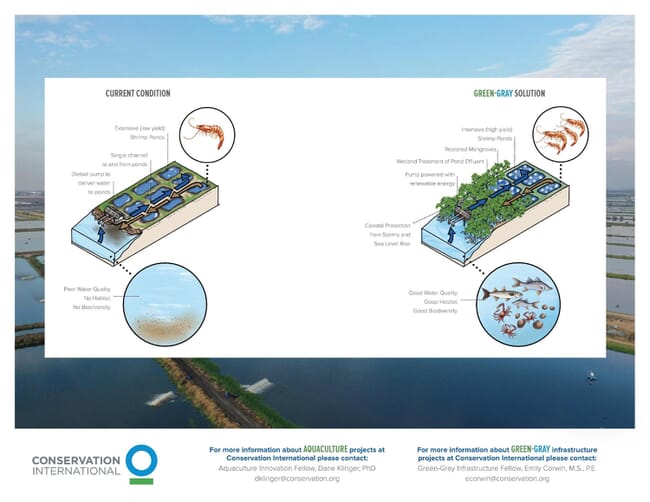
Extensive systems have a high spatial footprint and low pollution risk, while more intensive systems have smaller spatial footprints and higher pollution risks © FAO
Undertaken by Conservation International’s Aquaculture and Green-Gray Infrastructure programmes, the new study compares the efficacy, economics, spatial requirements and ecosystem services provision of multiple effluent treatment systems. The conclusion suggests that a nature-based solutions (NbS) approach to effluent management could be a viable way for the shrimp aquaculture sector to address nutrient-rich pollution risks, while also providing ecosystem service benefits.
Nature-based solutions are defined by the International Union for the Conservation of Nature as “actions to protect, sustainably manage and restore natural or modified ecosystems that [also] address societal challenges effectively and adaptively, simultaneously providing human well-being and biodiversity benefits.”
Shrimp aquaculture production has increased by 10,000 percent over the last four decades, growing from 74,000 tonnes in 1980 to 7.4 million tonnes in 2020, and growth is expected to continue. A new article, titled “A nature-based solutions approach to managing shrimp aquaculture effluent” reviews the environmental risks associated with nutrient-rich effluent, particularly in Asia where the industry has been trending towards more intensive production practices, and compares the costs and benefits of seven different treatment systems.

Coastal mangrove restoration can help to mitigate effluent pollution while also conferring climate adaptation and resilience benefits © Conservation International
Spatial expansion of the sector in the late 20th century came at the expense of critical coastal ecosystems, such as mangroves, which were cut down to create new shrimp ponds. While deforestation rates have slowed in recent years, new environmental risks have emerged, as farms are increasingly adding feeds and stocking shrimp at higher densities, increasing the nutrient content of effluent and the subsequent risk of polluting nearby aquatic ecosystems. The new research evaluates the potential for conventional and NbS effluent treatment options to address total nitrogen and total phosphorus across a spectrum of production intensities, while also considering their spatial footprint requirements, costs to implement and maintain, and provision of ecosystem services.
Nitrogen and phosphorus volumes were modelled to approximate effluent pollution risks across four production intensities. The authors took this approach to homogenise the pollutant inputs going into each treatment system but also as a necessity, due to a general lack of regional and global data on both commercial shrimp aquaculture production and its effluent management.
While international aquaculture certification bodies require strict compliance to water quality standards and data recording, the vast majority of shrimp producers globally are not certified. This lack of data around production and nutrient concentrations in effluent obscures potential risks to coastal water quality and eutrophication, especially in areas of high-density production or low hydrologic mixing (e.g. bays).
The results suggest that constructed mangrove wetlands, a type of NbS approach, are not only economically viable compared to more conventional approaches like settling ponds but can also provide additional ecosystem services. These types of wetlands, when properly designed, can effectively mitigate effluent while accommodating the intensification needs of aquaculture producers. However, the spatial footprint required for NbS systems to be effective were found to be much larger than conventional systems.
Conservation International is working to increase the adoption of NbS approaches to effluent management through their Climate Smart Shrimp initiative, where responsible intensification on a portion of a low-productivity farming area can help to finance and provide space for mangrove restoration on the remaining portion. A dedicated Climate Smart Shrimp Fund aims to take this approach to scale in Southeast Asia and Ecuador.
The new study highlights the viability of integrating mangrove restoration, as an NbS, into conventional aquaculture systems. Aquaculture production and profitability do not have to be sacrificed to effectively manage effluent and realise climate change mitigation and adaptation benefits and enhanced biodiversity.




